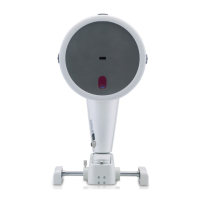6
3 Differences between the various
topography maps of Pentacam
®
3.1 Calculation of corneal power
Corneal Placido topographers measure geometrical corneal slope values. These values are converted
into curvature values e.g. values of axial (sagittal) curvature or instantaneous (tangential) curvature
which are initially given in mm. The Pentacam® measures geometrical height (elevation) values,
which are likewise converted into values of axial (sagittal) or instantaneous (tangential) curvature
and given in mm. These geometrical radius (mm) values are commonly converted it into refractive
power values, which are given in diopters (D). This is normally done according the simple formula of
D = (1.3375-1)*(1000)/Rmm.
A. The refractive effect
A sphere (sph) has the same radius of curvature at every point of its surface; however, due to
the phenomenon of spherical aberration (SA) its refractive power is not the same everywhere. If
the effect of SA is not taken into account, a corneal sphere with a radius of, say, 7.5 mm may be
considered to have the same refractive power of 45 D at every point of its surface (assuming the
keratometer calibration index of 1.3375, see below). Due to SA, however, the refractive power in the
periphery is actually higher. The Pentacam® refractive maps, as they are called, are calculated on the
basis of “Snell’s law” of refraction using precision ray tracing, thereby taking this effect into account.
B. Inclusion of anterior/posterior surface
By convention most keratometers use the refractive index of 1.3375 when calculating the dioptric
power of the anterior radius; in doing so they assume the cornea to have a single refracting
surface. However, it has been known for quite some time that this keratometric index is not the
best approximation to the rather physiological power of the cornea. Due to the contribution of
the posterior surface and the more rather refractive index of the cornea (n cornea = 1.376), the
True Net Power of the cornea, calculated using thick lens models or high-precision ray tracing,
is lower than the value reported by standard keratometry. The deviation between True Net Power
and corneal power as determined by standard keratometry (Sim K’s) becomes even greater when
dealing with corneas after excimer laser ablation (LASIK, LASEK and PRK) of the anterior surface.
After refractive corneal surgery it is no longer possible to calculate corneal refractive power based
only on the anterior surface, as the ratio between the anterior and posterior radius of the cornea
has changed considerably. When the calcultio of the total corneal astigmatism comes into focus the
effect of the posterior corneal surface cannot be disregarded anymore. Depending to the orientation
of the anterior and posterior corneal kertometry the total corneal astigmatism can be over or
underestimated and the axis of the total corneal astigmatism is influenced [1].
3 Differences between the various topography maps of Pentacam
®

